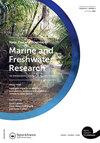Understanding the consequences of sea level rise: the ecological implications of losing intertidal habitat
IF 1.7
4区 环境科学与生态学
Q3 FISHERIES
New Zealand Journal of Marine and Freshwater Research
Pub Date : 2022-06-16
DOI:10.1080/00288330.2022.2086587
引用次数: 6
Abstract
ABSTRACT Sea level rise (SLR) has been described as one of the greatest potential causes of ecosystem disruption, putting many coastal areas at risk of irreversible changes. However, the loss of intertidal areas from SLR and the associated ecological and social repercussions receive little attention. Within estuaries, extensive intertidal areas harbour a variety of habitats and communities and represent hotspots of ecosystem functions. Any changes to their distribution or extent are likely to have far reaching implications. Here we summarise the ecological consequences of a reduction in intertidal area from increasing SLR, and the implications for people, management and planning. To facilitate this discussion, changes in the occurrence and abundance of two ecologically and culturally important intertidal shellfish species (Austrovenus stutchburyi and Macomona liliana) were modelled under different SLR scenarios for Tauranga Harbour, Aotearoa New Zealand. We highlight how the squeezing of intertidal areas will likely alter the distribution and extent of key habitats and communities, and discuss the implications for coastal food webs, ecosystem functioning and service provision. Pre-emptive planning and adaptive management are needed that incorporate ecological losses in risk assessments and focuses on pro-active solutions to increase resilience to the effects of SLR.了解海平面上升的后果:失去潮间带栖息地的生态影响
摘要海平面上升(SLR)被描述为生态系统破坏的最大潜在原因之一,使许多沿海地区面临不可逆转变化的风险。然而,SLR造成的潮间带损失及其相关的生态和社会影响很少受到关注。在河口内,广阔的潮间带拥有各种栖息地和群落,是生态系统功能的热点。其分布或范围的任何变化都可能产生深远的影响。在这里,我们总结了SLR增加导致潮间带面积减少的生态后果,以及对人员、管理和规划的影响。为了促进这一讨论,在新西兰奥特亚陶朗加港的不同SLR情景下,对两种具有重要生态和文化意义的潮间带贝类物种(Austrovenus stutchburyi和Macomona liliana)的出现和丰度的变化进行了建模。我们强调了潮间带的挤压可能会如何改变关键栖息地和社区的分布和范围,并讨论了对沿海食物网、生态系统功能和服务提供的影响。需要先发制人的规划和适应性管理,将生态损失纳入风险评估,并侧重于积极的解决方案,以提高对SLR影响的抵御能力。
本文章由计算机程序翻译,如有差异,请以英文原文为准。
求助全文
约1分钟内获得全文
求助全文
来源期刊
CiteScore
4.50
自引率
12.50%
发文量
35
审稿时长
3 months
期刊介绍:
Aims: The diversity of aquatic environments in the southern continents and oceans is of worldwide interest to researchers and resource managers in research institutions, museums, and other centres. The New Zealand Journal of Marine and Freshwater Research plays an important role in disseminating information on observational, experimental, theoretical and numerical research on the marine, estuarine and freshwater environments of the region.

 求助内容:
求助内容: 应助结果提醒方式:
应助结果提醒方式:


